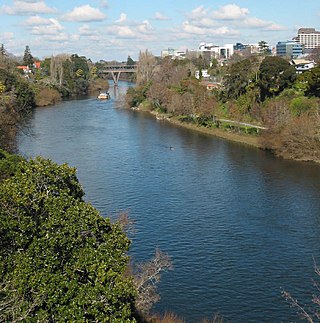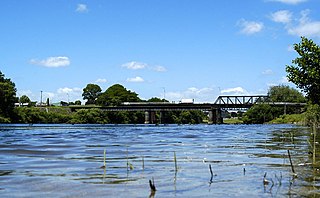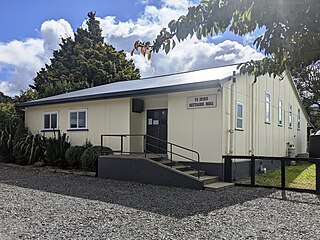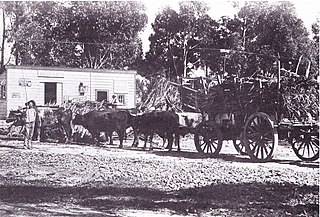Related Research Articles

Hamilton is an inland city in the North Island of New Zealand. Located on the banks of the Waikato River, it is the seat and most populous city of the Waikato region. With a territorial population of 179,900, it is the country's fourth most-populous city. Encompassing a land area of about 110 km2 (42 sq mi), Hamilton is part of the wider Hamilton Urban Area, which also encompasses the nearby towns of Ngāruawāhia, Te Awamutu and Cambridge. In 2020, Hamilton was awarded the title of most beautiful large city in New Zealand.

The Waikato River is the longest river in New Zealand, running for 425 kilometres (264 mi) through the North Island. It rises on the eastern slopes of Mount Ruapehu, joining the Tongariro River system and flowing through Lake Taupō, New Zealand's largest lake. It then drains Taupō at the lake's northeastern edge, creates the Huka Falls, and flows northwest through the Waikato Plains. It empties into the Tasman Sea south of Auckland, at Port Waikato. It gives its name to the Waikato region that surrounds the Waikato Plains. The present course of the river was largely formed about 17,000 years ago. Contributing factors were climate warming, forest being reestablished in the river headwaters and the deepening, rather than widening, of the existing river channel. The channel was gradually eroded as far up river as Piarere, leaving the old Hinuera channel through the Hinuera Gap high and dry. The remains of the old course are seen clearly at Hinuera, where the cliffs mark the ancient river edges. The Waikato's main tributary is the Waipā River, which converges with it at Ngāruawāhia.

Ngāruawāhia is a town in the Waikato region of the North Island of New Zealand. It is located 20 kilometres (12 mi) north-west of Hamilton at the confluence of the Waikato and Waipā Rivers, adjacent to the Hakarimata Range. Ngāruawāhia is in the Hamilton Urban Area, the fourth largest urban area in New Zealand. The location was once considered as a potential capital of New Zealand.

Te Awamutu is a town in the Waikato region in the North Island of New Zealand. It is the council seat of the Waipa District and serves as a service town for the farming communities which surround it. Te Awamutu is located some 30 kilometres (19 mi) south of Hamilton on State Highway 3, one of the two main routes south from Auckland and Hamilton.

Waikato District is a territorial authority of New Zealand, in the northern part of Waikato region, North Island. Waikato District is administered by the Waikato District Council, with headquarters in Ngāruawāhia.

Hamilton East is a suburb in central Hamilton in New Zealand. The suburb's primary commercial and retail precinct is located along Grey Street. Hamilton East is characterised by villas and bungalows built early in the 20th century.

Waikato Hospital is a major regional hospital in Hamilton, New Zealand. It provides specialised and emergency healthcare for the Midlands and Waikato area with patients referred there from feeder hospitals like Whakatāne, Lakes area, Tauranga, Thames, Tokoroa and Rotorua.

Rototuna is a suburb in northern Hamilton, New Zealand, east of Flagstaff. It is one of the newest and fastest-growing suburbs in Hamilton, along with neighbouring Huntington and Flagstaff.
Hamilton City Libraries are a group of six libraries in Hamilton, New Zealand, owned by the local city council. They lend fiction and non-fiction, magazines, audiobooks, CDs and DVDs. From November 2016 to 9 July 2018, a substitute library compensated for the temporarily closed Central branch, and the libraries closed for over 2 months for COVID-19 in 2020. Waikato residents without local libraries can freely use the Hamilton libraries.

Waikato County was one of the counties of New Zealand on the North Island. Under the Local Government Reorganisation Order of 1989, nearly all of the county was added to the boroughs of Huntly, Ngāruawāhia, most of Raglan County Council, and a small part of Waipa County Council, to form Waikato District Council.
Braemar Hospital is one of the New Zealand's largest private hospitals. It is owned by the Braemar Charitable Trust located in Hamilton, New Zealand. There was a separate and unrelated organisation, Braemar Hospital in Nelson, New Zealand which provided long term psychiatric care for children.

William Australia Graham was a New Zealand surveyor, mediator, farmer, politician and mayor. He was born in Auckland, New Zealand, on 22 November 1841, the third son of George Graham. He went to Clewer House School, Windsor, and Hele's School, Exeter and returned home in 1854.

Hamilton City Council is the territorial authority for the New Zealand city of Hamilton.
Matangi is a settlement in the Waikato District on the eastern border of Hamilton. It is surrounded by many lifestyle blocks, but the village centre has Matangi School, a garage, Four Square, takeaway and café, Matangi Hall, St David’s church and Matangi recreation reserve.
Horotiu is a small township on the west bank of the Waikato River in the Waikato District of New Zealand. It is on the Waikato Plains 13 km (8.1 mi) north of Hamilton and 5 km (3.1 mi) south of Ngāruawāhia. From early in the 20th century it developed around a freezing works and other industries.

John William Ellis was a New Zealand businessman and mayor of Hamilton from 1917 to 1918.

Te Miro is an area in the Waipa District of the Waikato Region of the North Island of New Zealand. Te Miro is situated 31 kilometres east southeast of Hamilton, and 24 kilometres northeast of Cambridge. Te Miro has a population of approximately 500.
Orini is a rural community in the Waikato District and Waikato region of New Zealand's North Island. It is located east of Taupiri

Te Kauwhata was a flag station on the North Island Main Trunk line, in the Waikato District of New Zealand, 54 mi (87 km) south of Auckland. It was 591.52 km (367.55 mi) north of Wellington, 3.32 km (2.06 mi) north of Rangiriri, 6.72 km (4.18 mi) south of Whangamarino and 12 m (39 ft) above sea level.

The Waikato District Health Board is a district health board with the focus on providing healthcare to the Waikato region of New Zealand.
References
- ↑ "Office of the Waikato District Hospital and Charitable Aid Board (Former)". www.heritage.org.nz. Retrieved 10 May 2020.
- 1 2 3 4 5 Mark Wallbank (2017). Haunted New Zealand Road Trip. New Holland Publishers. p. 172. ISBN 9781869664640.
- ↑ "Waikato District Health Board - Waikato Hospital by the numbers". waikatodhb.govt.nz. 2011. Retrieved 16 December 2011.
On December 1, 1886, the first meeting of the Waikato Hospital and Charitable Aid Board took place in Hamilton – a significant day, marking the birth of Waikato Hospital.
- ↑ "Papers Past — Auckland Star — 11 June 1888 — WAIKATO NOTES". paperspast.natlib.govt.nz. 2011. Retrieved 16 December 2011.
- ↑ "Office of the Waikato District Hospital and Charitable Aid Board (Former) record from New Zealand Historic Places Trust Pouhere Taonga". historic.org.nz. 2011. Retrieved 16 December 2011.
- ↑ "Waikato District Health Board - Waikato Hospital visiting times changed to suit patients recovery". waikatodhb.govt.nz. 2011. Retrieved 16 December 2011.
The 600-bed hospital on Waiora Waikato in Hamilton - Australasia's largest hospital campus site - serves a Waikato and central North Island population of more than 860,000 people.
- ↑ Rasmussen, Warwick (23 July 2009). "Bar to alterations 'pointless'". stuff.co.nz. Retrieved 4 April 2021.
- ↑ "Letters, July 22: Heritage is no handicap". stuff.co.nz. 2011. Retrieved 16 December 2011.
- ↑ Jonathan Carson; Angela Cumming (10 December 2011). "Waikato's Most Haunted" . Retrieved 23 December 2019.
Coordinates: 37°47′25″S175°17′07″E / 37.790356°S 175.285208°E